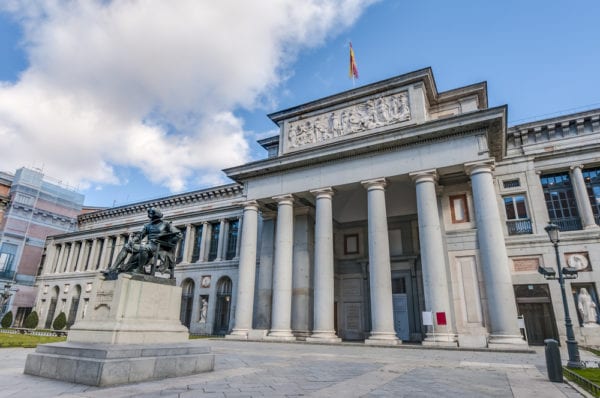5 must-see artworks at the Prado Museum, Madrid
5 must-see artworks at the Prado Museum, Madrid
5 must-see artworks at the Prado Museum, Madrid
-
Hannah
-
Hannah


Have you visited the Prado art museum in Madrid? It is one of my favourite places on the planet. Not only is the building itself beautiful, but it houses some of the most important and awe-inspiring artworks in the world.
The museum was commissioned in the late 18th century by Charles III for the natural history cabinet, but his grandson, Ferdinand VII, reimagined it as a royal museum showing off the crown’s vast art collection, to put Spanish art on the world map. It was opened to the public as the Royal Museum in 1819, and renamed the Museo del Prado by Isabella II in 1868. Art acquisitions continued apace as the years went by, so that since the early 20th century the museum has seen several expansion projects. Today, it is widely considered to hold one of the greatest collections of European art in the world, totalling some 8,200 drawings, 7,600 paintings, 4,800 prints and 1,000 sculptures. At the heart of these is the royal collection.
The museum features works by many important artists. For this article I’ve chosen just five out of so many pieces that are ‘must-see’ artworks. To view the full collection in detail, you can visit the museum online: http://www.museodelprado.es/en.
1. The Garden of Earthly Delights by Hieronymus Bosch (1490–1500)

Hieronymus Bosch was a Dutch painter of the Early Netherlandish painting school. He painted wonderfully detailed works that are rich in imagery, often from religious inspirations. The Garden of Earthly Delights is a triptych (a painting divided into three hinged sections; the outer two can be folded like shutters over the core painting). It is painted in oils on oak wood and depicts the Creation. On the left is Adam and Eve, in the centre a fantastical scene of people and creatures, and on the right a portrayal of damnation.
2. Knight with His Hand on His Breast by El Greco (1580)

Doménikos Theotokópoulos, known as El Greco (meaning The Greek), was a key figure in the Spanish Renaissance, a painter, a sculptor and an architect. He was born in Crete, but settled in Toledo, Spain, where he produced unique, dramatic artworks that would later inspire artists of the Expressionist and Cubist movements. Knight with His Hand on His Breast (also translated as Gentleman or Nobleman) is one of a series of El Greco paintings of noblemen in which the model is unknown. Some art historians believe this is in fact a self-portrait. For me, the hand on the breast speaks volumes – it creates emotion in the onlooker.
3. Las Meninas by Diego Velázquez (1656)

This is the most famous work at the Prado, a key attraction for visitors. Velázquez was the favourite artist in the court of King Philip IV and a major figure in the Spanish Golden Age. His style has been deeply influential; Pablo Picasso and Salvador Dalí, for example, recreated some of his works. Las Meninas means The Ladies-in-Waiting, and it depicts a complicated scene at the Royal Alcazar of Madrid. There are many layers to the scene that are open to interpretation, which makes it an artwork that provokes much discussion. The painter featured within the painting is Velázquez himself.
4. The Three Graces by Peter Paul Rubens (1635)

Rubens was a hugely prolific painter, producing more than 1,400 works in his lifetime. He was Flemish, and painted in the Flemish Baroque style. I have always loved the use of colour and the sensuality in Rubens works, as in The Three Graces. His works were often inspired by Christian allegories, but here he is depicting the Graces of Greek mythology: Aglaia, meaning charm, Euphrosyne, meaning joy, and Thalia, meaning blossoming. Together, these daughters of Zeus served Aphrodite and created joie de vivre. The left-hand Grace is modelled on Rubens wife Hélène, which is perhaps why he held on to his painting until his death – just five years after its completion.
5. La Maja Desnuda and La Maja Vestida by Francisco Goya


Francisco José de Goya y Lucientes was a very popular artist in his time, and ever since. His career spanned 50 years, during which he was appointed a court painter to the Spanish crown. La Maja Desnuda (The Naked Maja) was commissioned by a prime minister, who then asked for a second version of the painting in which the woman was clothed, which he could switch for the risqué one when conservative visitors came to his home. Still, the nude was discovered, and the alluring gaze of the model combined with the glimpse of her private area was most upsetting to the Church authorities. As a result, Goya was pulled before the Spanish Inquisition to explain his ‘moral depravity’ in painting the nude. His response, which saved him: he had emulated the Velázquez painting Venus which Philip IV had loved. Certainly, Goya was very influenced by Diego Velázquez; he said, ‘I have had three masters, Nature, Velasquez, and Rembrandt.’